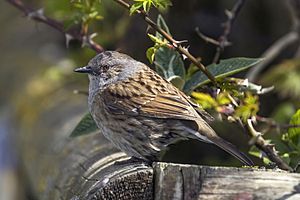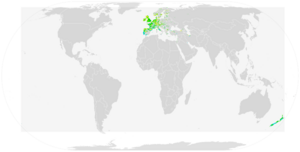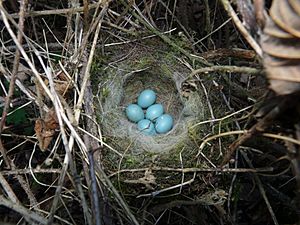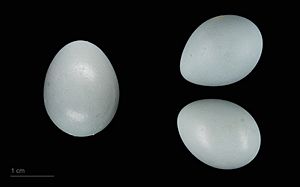Dunnock facts for kids
Quick facts for kids Dunnock |
|
|---|---|
 |
|
| Conservation status | |
| Scientific classification | |
 |
|
| Global range Year-Round Range Summer Range Winter Range | |
| Synonyms | |
|
The dunnock (Prunella modularis) is a small bird that likes to perch. You can find these birds across Europe and parts of Asian Russia. They have also been brought to New Zealand and now live there too.
Dunnocks are the most common type of bird in the accentor family. Other names for the dunnock include the hedge accentor, hedge sparrow, or hedge warbler.
Contents
What is a Dunnock?
The dunnock was first described by a Swedish scientist named Carl Linnaeus in 1758. He gave it the scientific name Motacilla modularis. The word modularis comes from Latin and means "singing."
Later, in 1816, a French bird expert named Louis Vieillot placed this bird in the group Prunella.
The name "dunnock" comes from an old English word meaning "dingy brown." The word "accentor" comes from Latin and means "someone who sings with another." The group name Prunella comes from a German word meaning "brown."
There are eight different types, or subspecies, of dunnocks:
- P. m. hebridium found in Ireland and the Hebrides (west of Scotland)
- P. m. occidentalis found in Scotland (except the Hebrides), England, Wales, and west France
- P. m. modularis found in north and central Europe
- P. m. mabbotti found in Spain, Portugal, south-central France, and Italy
- P. m. meinertzhageni found in the Balkans
- P. m. fuscata found in the south Crimean Peninsula (north Black Sea coast)
- P. m. euxina found in northwest and north Turkey
- P. m. obscura found in northeast Turkey, the Caucasus, and north Iran
What Does a Dunnock Look Like?
A dunnock is about the size of a European robin, measuring about 13.5 to 14 centimeters long. It has a streaky back, a bit like a small house sparrow. Dunnocks have a plain look, which might help them hide from predators.
They are brownish underneath and have a thin, pointed beak. Adult dunnocks have a grey head. Both male and female dunnocks look similar.
Dunnocks often flick their wings, especially when they are fighting over their space or trying to find a mate. This behavior is why they are sometimes called "shufflewings."
Dunnock Sounds
The main sound a dunnock makes is a sharp, constant tseep. They also make a high trilling sound. These sounds can help you find the bird, even though it tries to stay hidden.
Their song is fast, thin, and tinkling. It's a sweet, warbling sound. It can sometimes sound like the song of a Eurasian wren, but the dunnock's song is shorter and not as strong.
Where Do Dunnocks Live?
Dunnocks are originally from large parts of Europe and Asia. This includes places like Lebanon, northern Iran, and the Caucasus mountains. They are the only common accentor bird found in lower areas. Most other accentors live in mountains.
Dunnocks were brought to New Zealand in the 1800s. Now, they are found all over the country and on some nearby islands.
They like to live in woodlands, bushes, gardens, and hedgerows. They usually look for food on the ground, often eating small creatures that break down dead plants and animals.
Dunnock Territories
Dunnocks like to have their own space, called a territory. They might fight with other birds that come too close to their nests. Sometimes, male dunnocks share a territory. In these groups, there's usually a leader male and other males who follow.
However, being the leader doesn't always mean a male will have more babies. Often, all the males in a group share equally in fathering the chicks. Also, the birds in a group are usually not related, so they might still compete with each other.
Female dunnocks usually have their own territories that don't overlap with other females. But sometimes, a few males will work together to protect one territory that has several females. Older male dunnocks are usually the leaders, and younger males are not. Studies show that close male relatives almost never share the same territory.
How well a male can find a mate often depends on how big the female's territory is. This size is affected by how much food is available. If there's a lot of food in small areas, female territories are small. This makes it easier for males to find and stay with females. In these cases, males often have more success in having babies than females.
But if food is scarce, female territories become larger. This makes it harder for males to find and stay with females. In this situation, females have a better chance of having more babies than males.
Dunnock Reproduction and Life Cycle
How Dunnocks Mate
Dunnocks have many different ways of pairing up. Females often mate with two or more males at the same time. This is quite unusual for birds. When a female mates with multiple males, the males compete to be the father of the chicks.
Scientists can use DNA fingerprinting to find out who the father is. They have found that chicks in the same nest can have different fathers. This depends on how successful each male is at mating with the female. Males have special behaviors to increase their chances of being the father of the chicks. Dunnocks mate very quickly, in about one-tenth of a second. They can mate many times a day.
Males help care for the chicks based on how much they mated with the female. So, you might often see two males and one female feeding the baby birds at a single nest.
Other mating systems also happen, depending on how many males and females there are and how their territories overlap.
- If only one female and one male territory overlap, they usually mate only with each other (this is called monogamy).
- Sometimes, one male's territory overlaps with two or three female territories. In this case, the male mates with several females (this is called polygyny).
- There are also cases where two males work together to protect a territory that has several females (this is called Polygynandry).
- However, the most common way dunnocks mate in nature is when one female mates with several males (this is called Polyandry).
In general, males have the most success in having babies in polygynous groups. Females have the most success in polyandrous groups.
Studies have shown that dunnock mating systems can change. If there is a lot of food, female territories become much smaller. This makes it easier for males to find and stay with females. So, the mating system can change from one where females have more success (polyandry) to one where males have more success (monogamy, polygynandry, or polygyny).
Dunnock Nests and Eggs
Dunnocks build their nests mostly from small branches and moss. They line the nest with soft things like wool or feathers. They usually build their nests low down in a bush or a conifer tree. Female dunnocks typically lay three to five blue eggs that have no spots.
Caring for the Young
Depending on the dunnock group, baby birds can be raised in different ways:
- By a single female.
- By several females with a male helping part-time.
- By several females with a male helping full-time.
- By several females and several males.
When there is one male and one female, both parents help care for the chicks equally. But in groups with one female and two males, the female and the main male (alpha male) spend more time caring for the chicks than the other male (beta male).
In places where females can avoid the males, both the alpha and beta males share the feeding duties equally. This is the best situation for the females, as it means the young birds get the most care and have the best chance to survive.
A study found that male dunnocks usually don't tell the difference between their own chicks and those fathered by another male in groups where females mate with multiple males. However, they do change how much they feed the chicks based on how sure they are that they are the father. If a male had more chances to mate with a female, and therefore a higher chance of being the father, he would provide more care for the young.
See also
 In Spanish: Acentor común para niños
In Spanish: Acentor común para niños






